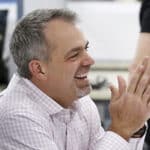Fuel Growth Podcast: Embracing a People-First Culture
On this episode of the Fuel Growth podcast series, my co-host Lizzy and I got to sit down with 6Sense’s Chief People Officer, Terese Lam. 6sense is a predictive intelligence platform for marketing and sales that uses artificial intelligence (AI), big data, and machine learning to detect anonymous buying activity, find hidden buyer behavior to capture more revenue, and help marketing and sales teams develop campaigns with more intelligence.
As Chief People Officer, Terese leads the People Team and is passionate about driving impact through empowering, developing, and challenging people to be the best version of themselves. With over 20+ years of HR experience in both large multi-national and medium-sized high-growth organizations, Terese is an expert when it comes to creating and implementing a culture of growth.
Why a People-First Culture of Growth is Important
A people-first culture of growth mindset focuses less on the metrics and numbers behind performance and more on motivating and encouraging employees on a personal level to hit their targets. When you balance alignment between KPIs and core values, you start to create a level of accountability and respect that enables organizations to continuously improve, all while growing people, teams, culture, and business.
This type of growth involves an executive, top-down buy-in, which means your entire organization must be willing to accept and embrace change to achieve rapid growth. Terese added, “the speed of change is even greater now. You know, ten years ago, companies were fueled by technology and our need for digital transformation, but things are different now. At the end of the day, if you’re not innovating, you’re not disrupting, and if you’re not disrupting, you will be disrupted”. If your company is not willing or able to change, it cannot keep up with the pace of its competitors.
The Four Main Pillars Supporting a Growth Culture Mindset
Pillar 1: Creating a Culture Code
Building a plan starts with a ‘culture mindset’. A culture mindset is an organizational rally cry that prioritizes continuous learning, improvement, and innovation.
Terese said this best when she stated, “you need to start with the ‘why’. ’Why do you exist?’ Or ‘what’s the big vision?’ It frames everything. Once you align to those values, you can start to attain your purpose and what growth means to your company.”
In order to successfully shift to a growth-oriented culture, everyone, from CEO to intern, must be 100% on board. It’s not enough for leadership to familiarize employees with your core values they really need to take the time to explain to the company why these are your core values. Only then can the employees clearly understand what your company stands for.
Pillar 2: Fostering Innovation Through a Diverse Workforce
Diversity is a key driver of innovation and is a critical component of being successful for modern B2B enterprises. If done correctly, the short and long-term impacts will be wildly significant to overall employee engagement, performance, and retention. Terese said, “you have to look at your people and make sure you have a diverse representation, …people who can share different thoughts and opinions and experiences. From there, you need to make sure managers and leaders are exemplifying that sort of growth and having a growth mindset”.
Leadership must ‘walk the walk’ and lead the way when it comes to shaping their work environment. Your employees are inspired by what they see others doing, not by what they are told to get excited about.
Pillar 3: Adopting Systems and Tools that will Move the Needle
“Systems and tools and processes are the third component, especially when you are looking at the systems and tools that will help drive efficiency and not slow you down. There’s a fine balance between agility and destructor when it comes to technology”, Terese added, “another thing around systems and processes is to make sure you’re recognizing and rewarding experimentation and new approaches to technology and processes that lead to higher performance.” Innovation should be accoladed, especially if it leads to greater employee satisfaction, an increase in personal connections, and strengthened communication.
Pillar 4: Fostering a Safe Environment for Risk Taking
Learning how to adapt to change is a top-down initiative. Business leaders need to avoid being afraid to fail—failure is an imperative aspect of growth culture. Without experimenting and failing, you will never be able to uncover that one great idea that helps your organization take flight and make noise in a truly competitive market.
Terese added, “the fourth component is about the environment. You need to make sure you’re not only agile but that you bake flexibility and efficiency into all your plans. It’s a very important part of a growth culture that leadership allows for people to experiment and gives them a safety net to experiment and make mistakes”.
How to Embrace Change to Successfully Create a Culture of Growth
These pillars are important for organizations to create a people-first culture of growth, but there’s one main thing that every company needs to nurture in order to successfully implement these: the ability to recognize and respond to change.
Terese added, “think about your mindset. It’s not something that you can just flip a switch and change—It takes time. Developing a growth mindset isn’t a fixed or linear thing; it has to be a journey. And with that, you’re developing over time, and you’re creating an environment that supports your people. In order to embrace change, you first need to accept that change is inevitable. Once you accept that, you can really begin to grow”.
Top Three Lessons Learned
Terese shared with us the top three lessons she’s learned or has seen throughout her career while growing a company.
Lesson 1: Companies Can’t Afford to Grow at All Costs
Terese started this lesson by saying, “growing at all costs…certainly in tech over the last two years… that’s sort of been the motto. You have a problem, you throw money at it, or headcount.” But that’s not the case in today’s economy. Terese went on to explain, ”we need to be able to take a step back and be much more planful about how we spend and how we look at things such as organization design and the systems and platforms we use. Every expense should matter. Everything that you bring in should make a difference and have an ROI tied to it. And now, with budgets tighter than ever, it’s amazing to see how creative people can get”. Even in the face of dwindling budgets, looking at operational efficiencies as well as the ROI on every spend is critical for leaders to make sure that every dollar counts.
Lesson 2: Putting in Place Building Blocks to Help Your Company Scale
As companies grow, leaders should prioritize putting in place repeatable and systematic approaches to every aspect of the company. This can save them from headaches further down the line. Terese gave these examples of building blocks she personally put in place, “we had compensation policies that had worked well when the company was 200-300 employees, right? But they were not the appropriate ones as we grew to 1,300. When you don’t have the right compensation levels and philosophy around things, issues can start to rise. If there’s an issue, and you start to make exceptions, eventually one exception becomes another exception, and now you have a snowball of an issue. You’ve created a huge mess that you have to clean up. But, when you have those things in place beforehand, like workforce planning, you have a strategy set in stone, with no wiggle room on how to handle these issues”. Having a scalable plan in place is a great first step for organizations to take a step back and assess their current plans and models and optimize them to meet current and future needs.
Lesson 3: Talent Review
Headcount and talent are major things leaders can lean on when they’re looking to grow and scale their company. Terese went on to say, “in every company I’ve been at, doing a talent review or talent planning within the organization is critical. It’s sitting down with my team and making sure we have the right people in the right roles that will help us scale and vice versa, recognizing who might be limiting us from scaling. You get to a point where you need to see scale, so you begin to plan ahead and bring in a mix of people who have seen scale before and have been a part of a growing company. It’s also identifying the people you currently have in your company who have that institutional knowledge and then complementing and supplementing that with people to scale”. At the end of the day, you need both, so bringing in the right mix of people, and starting those conversations early, is important.
Transitioning to a Growth-Oriented Culture
Fueling growth within an organization requires leadership to walk a fine line in order to find the right balance between challenging and nurturing for their workforce. There are two sides to the coin. Leaders need to help their employees feel supported and empowered in their work and they need to provide them with the drive and resources needed to succeed. Only then can employees deliver the utmost to their customers, colleagues, and the company.
Want to learn more on the subject? Listen to our full podcast conversation here for a more in-depth look into how prioritizing a culture of growth within your organization can help both your employees and your bottom line. If you want to catch up on our previous episodes, you can do so here or on your favorite podcast app.

